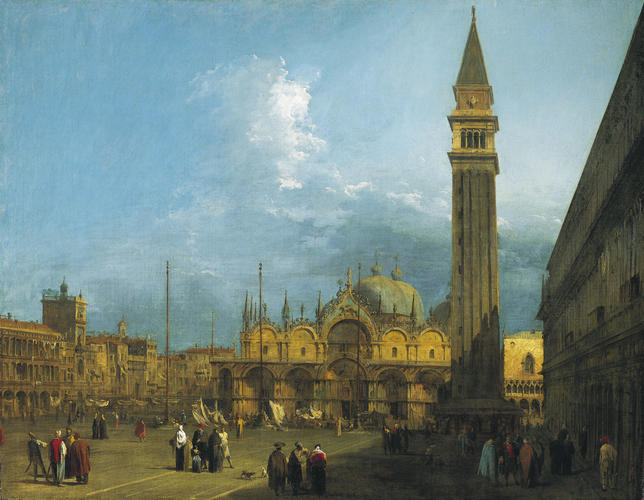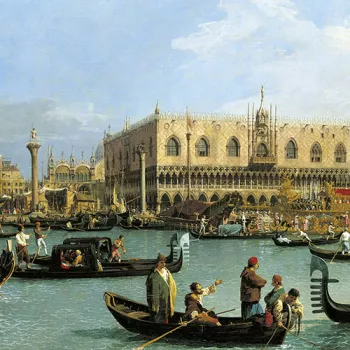Piazza San Marco looking East towards the Basilica and the Campanile c.1723-4
Oil on canvas | 135.0 x 172.8 cm (support, canvas/panel/stretcher external) | RCIN 405934
-
This painting forms one of a set of six views of the Piazza San Marco and the Piazzetta. The series may have been Canaletto's earliest commission from Joseph Smith, British Consul in Venice, who sold his works by the artist to George III in 1762. The set is all of the same size and, judging from the compositions and broad handling of paint, was probably intended to be incorporated symmetrically into the decoration of a single Venetian room. Four of the views are upright in format while this painting and its pendant (RCIN 405935) are horizontal; the pendant shows the opposite view of Piazza San Marco looking west. A closely related preparatory drawing for each view (also in the Royal Collection) may have been the basis for discussion between artist and patron. The care taken over the composition of the architecture and the changes made during the course of painting suggest that the balance and effect of the whole was important to both of them. Each painting in the set has the principal weight of building on either the left or as here on the right. In both this painting and its preparatory drawing, Canaletto drastically reduces the height and width of the Campanile, so as not to overwhelm San Marco and to create compositional balance. The viewpoint in the painting is higher and the Basilica more squat and wider than in the drawing.
Canaletto's training as a painter of theatrical scenery can be recognised in the creation of a clearly defined architectural space in subdued colours, animated by the brightly coloured figures and temporary booths. A ruling instrument was used for the Campanile and the roof of the Procuratie Nuove and dividers for each arch on the façade of the Basilica. The mid-day sun brilliantly highlights the Palazzo Ducale, its pattern of bricks created with the end of a brush dragged through a wet upper layer of paint, in contrast to the Procuratie Nuove with its diagonal shadow cast across the Campanile and part of the Piazza. The sunlight illuminates the upper parts of two strategically placed groups of figures, their bright colours painted with fluid, broad brush strokes. The striking contrasts of light, the expansive skies with swirling clouds, the emphasis on diagonals, and the broad fluid strokes defining the figures have been compared to those in The Stonemason's Yard (London, National Gallery) painted before August 1725 and the series of four paintings commissioned by Stefano Conti (private collection) dated 1725-6.
The paintings appear to have arrived in London unframed or without substantial frames; if so, this would strengthen the suggestion that they had been set into a room in one of Smith's houses in Italy. George III framed them in English 'Maratta' frames and hung them in the Entrance Hall of Buckingham House. When Horace Walpole saw them, he described them as 'bolder, stronger & far superior to his [Canaletto's] common Works'.
Text adapted from Canaletto and the Art of Venice, London, 2017.Provenance
Acquired in 1762 by George III from Joseph Smith, British Consul in Venice (Italian List nos 63-4); recorded in the Hall of Buckingham Palace in 1790
-
Medium and techniques
Oil on canvas
Measurements
135.0 x 172.8 cm (support, canvas/panel/stretcher external)
159.7 x 200.5 x 15.5 cm (frame, external)
Other number(s)
Alternative title(s)
Venice: Piazza S. Marco with the Basilica and Campanile









